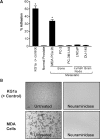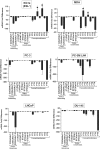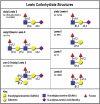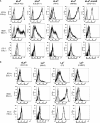Analysis of glycosyltransferase expression in metastatic prostate cancer cells capable of rolling activity on microvascular endothelial (E)-selectin
- PMID: 18647941
- PMCID: PMC2574550
- DOI: 10.1093/glycob/cwn070
Analysis of glycosyltransferase expression in metastatic prostate cancer cells capable of rolling activity on microvascular endothelial (E)-selectin
Abstract
Prostate cancer (PCa) cell tethering and rolling on microvascular endothelium has been proposed to promote the extravasation of PCa cells. We have shown that these adhesive events are mediated through binding interactions between endothelial (E)-selectin and Lewis carbohydrates on PCa cells. Prior data indicate that E-selectin-mediated rolling of bone-metastatic PCa MDA PCa 2b (MDA) cells is dependent on sialyl Lewis X (sLe(X))-bearing glycoproteins. To explore the molecular basis of sLe(X) synthesis and E-selectin ligand (ESL) activity on PCa cells, we compared and contrasted the expression level of glycosyltransferases, characteristically involved in sLe(X) and ESL synthesis, in ESL(+) MDA cells among other ESL(-) metastatic PCa cell lines. We also created and examined ESL(hi) and ESL(lo) variants of MDA cells to provide a direct comparison of the glycosyltransferase expression level. We found that normal prostate tissue and all metastatic PCa cell lines expressed glycosyltransferases required for sialo-lactosamine synthesis, including N-acetylglucosaminyl-, galactosyl-, and sialyltransferases. However, compared with expression in normal prostate tissue, ESL(+) MDA cells expressed a 31- and 10-fold higher level of alpha1,3 fucosyltransferases (FT) 3 and 6, respectively. Moreover, FT3 and FT6 were expressed at 2- to 354-fold lower levels in ESL(-) PCa cell lines. Consistent with these findings, ESL(hi) MDA cells expressed a 131- and 51-fold higher level of FT3 and FT6, respectively, compared with expression in ESL(lo) MDA cells. We also noted that alpha1,3 FT7 was expressed at a 5-fold greater level in ESL(hi) MDA cells. Furthermore, ESL(lo) MDA cells did not display sLe(X) on glycoproteins capable of bearing sLe(X), notably P-selectin glycoprotein ligand-1. These results implicate the importance of alpha1,3 FT3, FT6, and/or FT7 in sLe(X) and ESL synthesis on metastatic PCa cells.
Figures






Similar articles
-
Alpha 1,3 fucosyltransferases are master regulators of prostate cancer cell trafficking.Proc Natl Acad Sci U S A. 2009 Nov 17;106(46):19491-6. doi: 10.1073/pnas.0906074106. Epub 2009 Nov 4. Proc Natl Acad Sci U S A. 2009. PMID: 19889975 Free PMC article.
-
Human fucosyltransferase 6 enables prostate cancer metastasis to bone.Br J Cancer. 2013 Dec 10;109(12):3014-22. doi: 10.1038/bjc.2013.690. Epub 2013 Oct 31. Br J Cancer. 2013. PMID: 24178760 Free PMC article.
-
Circulating tumor cells from prostate cancer patients interact with E-selectin under physiologic blood flow.PLoS One. 2013 Dec 27;8(12):e85143. doi: 10.1371/journal.pone.0085143. eCollection 2013. PLoS One. 2013. PMID: 24386459 Free PMC article. Clinical Trial.
-
Carbohydrate-mediated cell adhesion involved in hematogenous metastasis of cancer.Glycoconj J. 1997 Aug;14(5):577-84. doi: 10.1023/a:1018532409041. Glycoconj J. 1997. PMID: 9298690 Review.
-
Selectins and glycosyltransferases in leukocyte rolling in vivo.FEBS J. 2006 Oct;273(19):4377-89. doi: 10.1111/j.1742-4658.2006.05437.x. Epub 2006 Sep 5. FEBS J. 2006. PMID: 16956372 Review.
Cited by
-
Comparing the Immunoexpression of FUT3 and FUT6 between Prostatic Adenocarcinoma and Benign Prostatic Hyperplasia.Acta Histochem Cytochem. 2013 Jun 27;46(3):105-9. doi: 10.1267/ahc.13010. Epub 2013 Jun 20. Acta Histochem Cytochem. 2013. PMID: 23836950 Free PMC article.
-
De novo assembly and characterization of breast cancer transcriptomes identifies large numbers of novel fusion-gene transcripts of potential functional significance.BMC Med Genomics. 2017 Aug 29;10(1):53. doi: 10.1186/s12920-017-0289-7. BMC Med Genomics. 2017. PMID: 28851357 Free PMC article.
-
Selectin ligand sialyl-Lewis x antigen drives metastasis of hormone-dependent breast cancers.Cancer Res. 2011 Dec 15;71(24):7683-93. doi: 10.1158/0008-5472.CAN-11-1139. Epub 2011 Oct 24. Cancer Res. 2011. PMID: 22025563 Free PMC article.
-
Over-sulfated glycosaminoglycans are alternative selectin ligands: insights into molecular interactions and possible role in breast cancer metastasis.Clin Exp Metastasis. 2013 Oct;30(7):919-31. doi: 10.1007/s10585-013-9592-7. Epub 2013 Jun 6. Clin Exp Metastasis. 2013. PMID: 23739843
-
3'-Sulfo-TF Antigen Determined by GAL3ST2/ST3GAL1 Is Essential for Antitumor Activity of Fungal Galectin AAL/AAGL.ACS Omega. 2021 Jul 1;6(27):17379-17390. doi: 10.1021/acsomega.1c01544. eCollection 2021 Jul 13. ACS Omega. 2021. PMID: 34278124 Free PMC article.
References
-
- Aubert M, Panicot-Dubois L, Crotte C, Sbarra V, Lombardo D, Sadoulet MO, Mas E. Peritoneal colonization by human pancreatic cancer cells is inhibited by antisense FUT3 sequence. Int J Cancer. 2000;88:558–565. - PubMed
-
- Benharroch D, Dima E, Levy A, Ohana-Malka O, Ariad S, Prinsloo I, Mejirovsky E, Sacks M, Gopas J. Differential expression of sialyl and non-sialyl-CD15 antigens on Hodgkin-Reed-Sternberg cells: Significance in Hodgkin's disease. Leuk Lymphoma. 2000;39:185–194. - PubMed
-
- Benjamin R. Neurologic complications of prostate cancer. Am Fam Physician. 2002;65:1834–1840. - PubMed
-
- Biol-N’garagba MC, Niepceron E, Mathian B, Louisot P. Glucocorticoid-induced maturation of glycoprotein galactosylation and fucosylation processes in the rat small intestine. J Steroid Biochem Mol Biol. 2003;84:411–422. - PubMed
Publication types
MeSH terms
Substances
Grants and funding
LinkOut - more resources
Full Text Sources
Medical
Research Materials

